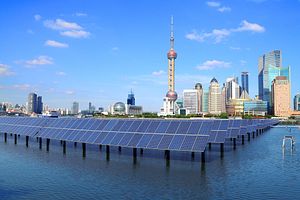Gray, smoggy cities and black manufacturing wastelands–these are the images that dominate international headlines about China’s environment. Heavy industry, the pressing need to generate energy and jobs for more than 1.3 billion people, and the systematic failure of adhering to operational standards has led to dangerous levels of pollution and environmental degradation. However, the need for more sustainable practices has not gone unrecognized by the Chinese Communist Party (CCP). In fact, since 2012, China has consistently ranked as the world’s biggest investor in renewable energy.
The sheer size of China’s population and economy means its energy decisions have massive consequences. In 2007, China became the world’s largest emitter of greenhouse gases. By 2035, China’s ratio in global energy demand is predicted to rise from the current 22 percent to 26 percent, and its world share of CO2 emissions, already the largest in the world, is predicted to rise by over a third, to account for 30 percent of the world’s output by 2035. But China also has the largest renewable energy reserves in the world. Currently it holds roughly 24 percent of the world’s renewable energy capacity and given China’s ongoing investments, that share is expected grow.
China’s strategy for a more sustainable energy sector is two-pronged, focusing on bolstering green energy infrastructure and investing in R&D to make both green and non-renewable energy production methods more efficient. Over the past decade, China has passed many laws and goals for expanding renewable energy. Notably, China’s five-year plans have pursued an aggressive renewable energy policy, pushing to increase renewable energy production to 15 percent of the total energy mix by 2020. Heavy government investment and subsidies for both government owned and private companies will be a key driver in succeeding these goals.
The big push to expand the green sector has reaped promising results. Renewables are becoming a rising share of the Chinese energy sector. The billions of dollars that the CCP has funneled into developing the clean energy sector has given Chinese companies a major push in the world market for clean energy development. For instance, in 2013, China invested $4.3 billion in its smart grid market, taking the world lead from the United States.
Promisingly, the share of energy produced by coal, a water-intensive and dirty energy source, has been declining incrementally. Coal produces about 70 percent of China’s energy, and China accounts for half the world’s coal consumption. However, the push for renewable energy is slowly changing things. Chinese coal production in 2014 dropped by a little more than 2 percent, and is forecast to drop even more by the end of this year. At this rate, Bloomberg New Energy Finance predicts that China’s power sector carbon emissions could be in decline by 2027, though coal will still continue to supply over 50 percent of China’s energy.
Aside from domestic investments in clean energy, China also has a long reach abroad. With $396 billion and $135 billion invested abroad in energy and transportation respectively, and along with the recent creation of the Asian Infrastructure Investment Bank, China commands tremendous influence over the development of clean energy sectors around the world.
However, China’s green energy sector is not without its issues. Many of China’s green energy companies are heavily subsidized by the CCP. Their long-term success will depend on their ability to be profitable once government assistance is reduced, especially in the wake of an appreciating yuan and slowing economic growth. After all, this is not the first sector that the CCP has rapidly expanded through enormous government subsidies. For instance, China’s steel industry shot from the world’s fifth biggest producer of steel to the first in the span of a year (from 2005 to 2006) largely through energy subsidies. Yet many of the steel companies grew dependent on subsidies for growth and found their profitability faltering. Many were ultimately unable to pay back the mounting debts from their rapid expansion and unprofitable, inefficient ventures. Now a similar, but not necessarily inevitable, danger faces the renewable sector.
Already consuming nearly a quarter of global energy, China and its energy path, its successes and failures, have great consequences for the future of sustainable development. It can serve as a model on which to build more sustainable infrastructure and expand the renewable sector, but it may also serve as a warning of the pitfalls that may be encountered. With concrete legal framework in place and already promising signs of transition, the greening of China’s energy structure will be watched with great interest.
Cynthia Kao is the Sustainable Development Fellow for Young Professionals in Foreign Policy. She holds a Master’s degree in International Development from the Josef Korbel School of International Studies and currently works in Washington, D.C.

































